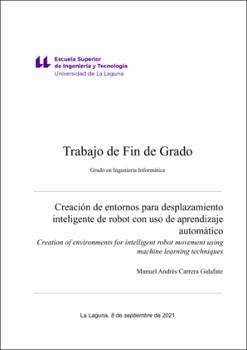Creación de entornos para desplazamiento inteligente de robot con uso de aprendizaje automático.
Date
2021Abstract
Dentro de los subsistemas principales de un robot móvil, se encuentra el sistema de navegación.
Este sistema es el encargado de definir una ruta desde el punto actual donde se encuentra el robot,
hasta su destino, esquivando obstáculos y evitando situaciones de riesgo.
Este TFG se centrará en el estudio de la creación de un planificador dinámico para robots móviles utilizando herramientas de aprendizaje automático, o machine learning. Se utilizará un escenario de simulación de robots móviles en entornos complejos, para entrenar el mejor comportamiento posible a partir de una serie de simulaciones con comportamiento aleatorio. De esta manera se podrá usar este planificador dinámico como base para generar uno en el futuro capaz de esquivar obstáculos, no basado únicamente en la posición actual de estos obstáculos, sino en la posición que tendrán en un futuro próximo, evitando posibles colisiones con antelación.
El carácter de esta memoria es mayormente práctico, nuestro fin es documentar los pasos que
se han seguido para componer el sistema para que estos sean reproducibles en el futuro, logrando
así poder entrenar otros sistemas robóticos, entrenar mediante el uso de otros algoritmos o arquitecturas de red neuronal, y en general inspirar al lector a realizar su propia experimentación con sistemas compuestos por robótica e inteligencia artificial. In the main subsystems of a mobile robot, there is the navigation system. This system is responsible for defining a route from the current location of the robot to the destination, avoiding obstacles and preventing risky situations.
This TFG will focus on the study of the creation of a dynamic planner for mobile robots using machine learning tools. A simulation scenario of mobile robots in complex environments will be used to train the best possible outcome from a series of simulations with random behavior. In this way, it will be possible to use this dynamic planner as a basis to create in the future a one capable of avoiding obstacles, not only based on the current position of these obstacles, but also on the position they will have in the near future, avoiding possible collisions in advance.
The character of this report is mostly practical, our goal is to document the steps that have been
followed to compose the system so that these are reproducible in the future, thus making it possible
to train other robotic systems, train using other algorithms or neural network architectures, and in
general give some inspiration to the reader to perform their own experimentation with systems
composed of robotics and artificial intelligence.





